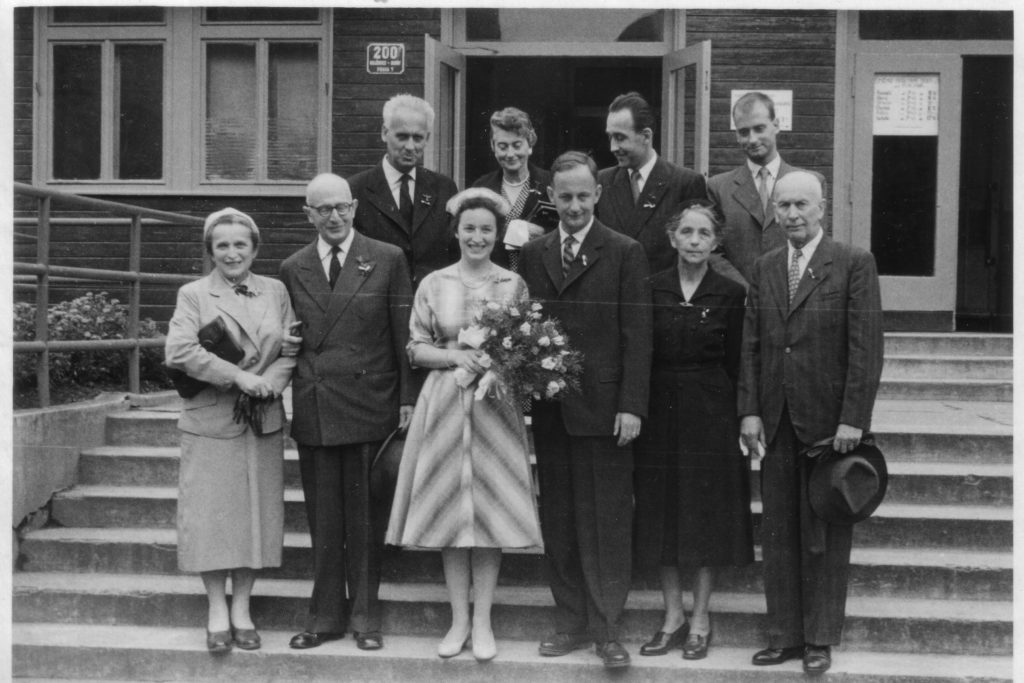Irma Lauscherová, the first-born child of Růžena and Jaroslav Kohn, was born on May 2, 1904 at Heřmanův Městec, a town known for its prominent and large Jewish religious community. Her father Jaroslav owned one of the town´s footwear factories. Five years later, another member, Irma´s brother Georg, was born to the family that lived in one of the houses on the square. The Kohn family followed the commandments of the Jewish faith, both of their children were raised in respect for the traditions of the Jewish nation.
After World War I the family moved to Prague where Irma attended the Eliška Krásnohorská Municipal High School for Girls, formerly known as Minerva. She later went on to extend her education by studying pedagogy, psychology, German and French languages at the Charles University and eventually received a diploma of a high-school professor.

While in Prague, Irma trained children in the Makabi sports club and joined the Jewish youth movement Techelet lavan. There she also met her lifelong love, Jiří Lauscher, who shared her enthusiasm for the construction of a Jewish nation state in the territory of the then Palestine; Jiří left for Palestine in 1925. Irma waited for him the next five years, devoting herself to her job of a teacher at a recently founded private Jewish school in Jáchym Street. She was called to her teaching job still before ending her own university studies. From the very beginning of her career the young teacher preferred to apply the methods of reform pedagogy, quite modern for that time. Instead of the typical authoritarian approach to children she did her best to create an atmosphere conducive to each pupil´s development and assertion of his or her own personality. In addition to Zionism, it was education and upbringing of children that proved to be her lifelong credo.
After Jiří Lauscher´s return to Czechoslovakia, the young couple cherished plans to settle in Palestine. However, these plans were hampered because of their fears to leave Irma´s recently widowed mother alone in the country. As a result, Irma and Jiří deferred their plan to emigrate for a later date. Meanwhile, they married in 1932 and the subsequent family events kept postponing their departure. Their daughter Michaela was born in 1936, and the Lauschers hired a nanny for the baby so that Irma could return to her job as soon as possible. At that time, the Jewish religious community (JRC) was holding requalification courses for youth so that young people could acquire qualifications vital for obtaining visa to travel abroad. Irma worked at the JRC as a teacher and instructor in requalification courses for girls, sharing her own knowledge and skills in childcare and in other fields.

In the school year 1939/1940 Irma resumed teaching in the Jewish school in Prague´s Jáchym Street, mostly German, until the forced closure of the school in the summer of 1942. After the war many of her former pupils remembered their teacher Irma Lauscherová and her teaching methods. Their recollections pieced together a picture of an exceptionally strict teacher, exacting as far as pupils´ behavior was concerned; and even though she was not a typical teacher loved by every pupil, she was widely respected, just and eager to help, whenever needed. Several decades later, Irma Lauscherová herself described the position of teachers at that time as follows: ”Without regard to one´s personal life, one´s inner trepidations and forebodings of the things to come we tried to maintain calm and composure, to accomplish our task.“[1] Following the total ban on the education of Jewish children she actively joined the system of clandestine teaching, organized in small groups in apartments; lessons were always reserved for several Jewish families at a time. By then the Lauschers lived in a single room in an old house in Žižkov quarter, where they had to move, leaving their original flat at Letná. Furthermore, after the family was forced to dismiss their nanny Irma had to manage full care of her only daughter Michaela on her own. A landmark came in December 1942 when the whole family was deported to the Terezín Ghetto; its members were separated in the camp for a long time. After more than a year, the Lauschers managed to set up their common, although modest, accommodation in an attic of the local town hall where the three could live together.

Thanks to her acquaintances in the management of the camp´s Youth Care Department, shortly after her arrival in Terezín Irma was given a job in childcare. In her clandestine teaching and upbringing of children Irma worked closely, for instance, with Nora Fried and Fredy Hirsch whom she greatly respected. Irma applied herself to teaching children even in her free time; for approximately a year she would visit her ill daughter who had to stay in the camp´s children hospital. On these occasions Irma would go round the hospital with her textbooks to teach small patients in their beds, or she would take recovering children out into the hospital yard and teach them various subjects there. Joined by some of her small charges, she also looked after a local maple tree, later known as The Tree of Terezín Children. The seeds for the tree had been smuggled into the Ghetto by an unknown inmate who worked outside the camp; the tree was planted in one of the Terezín yards in the spring of 1943; five years later, the tree was replanted during a solemn ceremony in the Jewish Cemetery in the Bohušovice Hollow. The exceptional merits of Irma Lauscherová in the care for Terezín children and youth were corroborated by the words of the legendary rabbi Leo Baeck who, at the end of his written evaluation of Irma´s work, dated May 23, 1945, wrote: ”Her personality and her legacy will be unforgettable.“[2]
Continuation of this article will be found in the next issue.
Jana Sumičová
[1] Stellmacher, Hildegart/Trautmann, Renate: Friede dem Fernen und Friede dem Nahen. (Peace to the Distant and the Near). Berlin: Metropol Verlag, 2009, p. 248 (in German).
[2] Ibid, p. 201.


